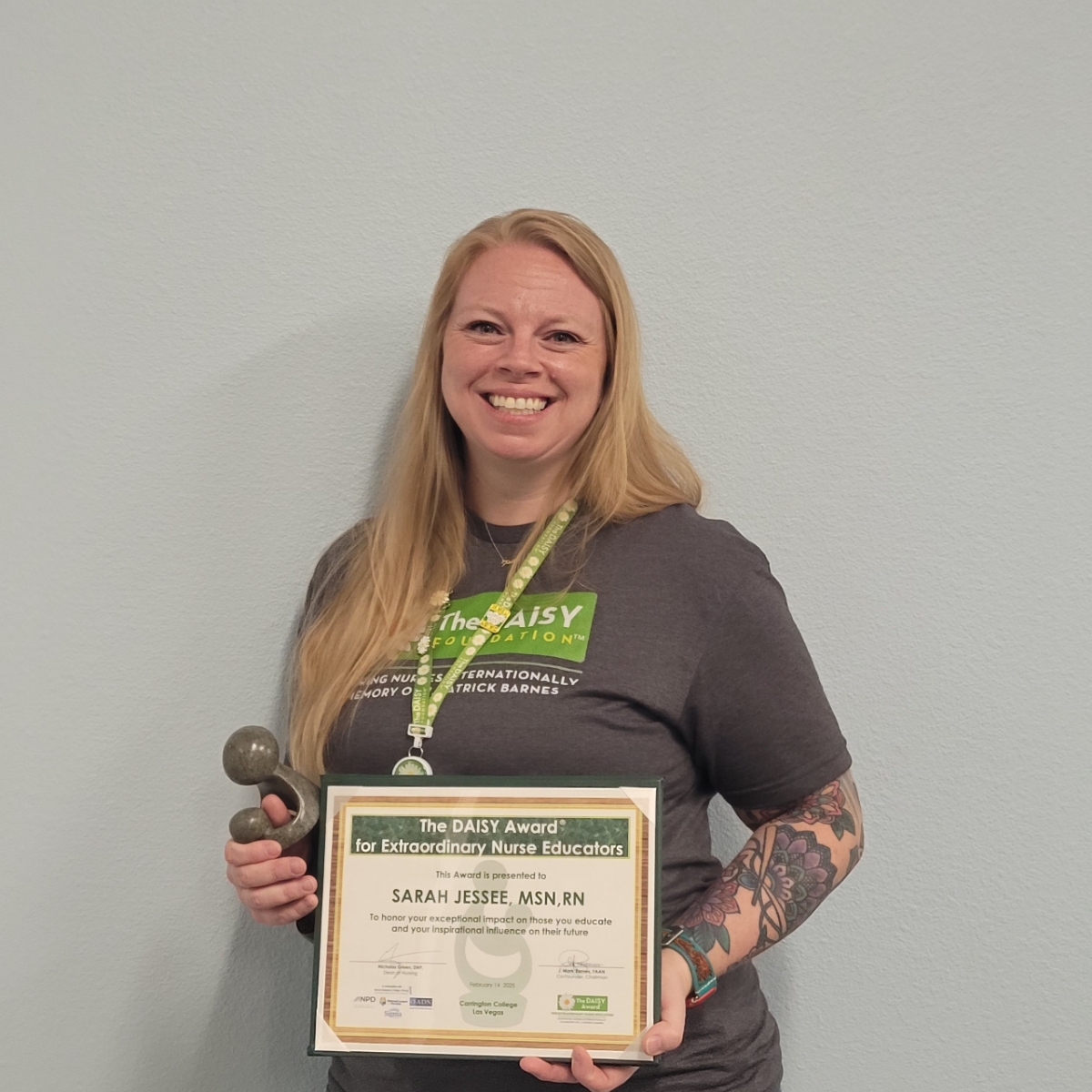 As a nurse on the front lines of patient care, Sarah Jessee worked with a lot of nursing students honing their medical and patient skills under her watchful eyes. She came to realize that she could influence students’ knowledge and practice to a greater degree by earlier participation in their education process. She found the perfect point of impact as an instructor for Carrington College’s Associate Degree in Nursing program. There, she could shape nursing students’ focus, ignite their skill level and inspire greater compassion for those they treat and their families.
As a nurse on the front lines of patient care, Sarah Jessee worked with a lot of nursing students honing their medical and patient skills under her watchful eyes. She came to realize that she could influence students’ knowledge and practice to a greater degree by earlier participation in their education process. She found the perfect point of impact as an instructor for Carrington College’s Associate Degree in Nursing program. There, she could shape nursing students’ focus, ignite their skill level and inspire greater compassion for those they treat and their families.
Sarah’s dedication to students in the college’s Associate Degree in Nursing program was recently recognized by her being given the DAISY (Diseases Attacking the Immune System) award. The DAISY Foundation honors those who go to extraordinary means to make a difference in the life of a patient, family member or medical colleague. Honorees are entitled to benefits throughout their careers. Read Sarah’s nomination here!
How did you find out you were receiving the DAISY award?
The DAISY award recognizes a commitment that is made to the medical field. Dr. Green, Dean of our nursing department, recently incorporated the DAISY award into our ‘pinning’ ceremonies, which occur three times each year. Students, staff and faculty vote on nominees.
I gave a spontaneous speech about how happy I am to serve our student population. My husband and sons (age 15 and 13) were there for the award presentation. And without my students that I am responsible for teaching and the teamwork of faculty, I would not have received this award.
How did you begin your medical career?
I started out as a Med/Surg (medical/surgical) nurse in 2014, moving to the operating room, and then emergency department. I was working with new (nursing) grads and saw how they struggled when they first got out on the floor. I knew what it was like for them and wanted to ease that transition from nursing student to practicing as a nurse. I wanted to have more hands-on effort to decrease their stress.
What brought you to teach at Carrington College’s ADN program?
I started here in 2023 as a part-time clinical lab instructor while completing my Master’s degree in February 2024. I had gone to full-time instructor just a month earlier.
Working with students, seeing where they’re coming from, feeling their struggles; it definitely helped me grow as a nurse. And seeing them experience probably one of the hardest things they have done, helps me see what I might give them to relieve some of that while I grew as a teacher.
How do you most want to influence future nurses?
I think many get into nursing because it sounds cool and pays a lot of money. But to truly be an effective nurse, you have to put another person’s needs before yourself.
Our students here to learn and I can share my love of nursing in the hope that they develop that same love.
What are some of your favorite moments in the classroom?
Listening to my students discus a specific question or topic and hearing them put the information into a language that another student better understands…and watching the lightbulbs come on – that’s exciting. Information doesn’t have to be taught in a certain way; it’s a powerful dynamic.
How do you work with students who struggle?
I say, “Let’s figure it out, then we can move forward.” We first have to know the cause.
Are there new teaching methods your medical programs are exploring?
We are diving into the world of simulation. Our students come into a room with a computerized mannequin and are given a nursing/medical scenario. They have to provide treatment responses, and their choices will determine whether the ‘patient’ lives or dies. Computerized feedback responds to their actions and treatments.
How is the mannequin used in training?
The mannequin is not mobile but can simulate breath and has a heartbeat and pulse. An instructor is behind a glass partition watching what treatments the students are providing.
What are the mannequin’s communication capabilities.
Our mannequin can simulate almost anything we want through its computer that we can program to present certain symptoms and responses to treatments. It can sweat, urinate, make vomiting/gagging sounds, project body temperature ranges, heart rate, breathing struggles or lose consciousness, go catatonic, flatline, and issue verbal responses (through the coach’s microphone). Its mouth may turn blue due to lack of oxygen and its heartrate might flatline. It can project a patient in cardiac arrest, or many other life threats or unidentified afflictions.
“Speaking” for the patient (mannequin) sometimes give us all a giggle. I explain to our students that patients are going to get fearful, angry and rude, depending on their situation. And it’s better that they learn to respond appropriately in a protected environment than in the moment at bedside.
What inspires you to teach at your highest level?
My own conscious voice. From the start of our class my students know my expectations and I don’t waiver from that. They seem comforted by that dynamic.
At the same time, I’m very flexible and adjust the way I approach a topic or teaching style based on the students I’m working with.
Do you struggle in your role as an educator?
I’m always asking myself, ‘What could I do better to make sure my students are getting what they need to be successful in their roles as medical providers?” We sit down with those who struggle and identify areas that need greater study.
I always tell them, “Let’s figure it out, then we can go forward.”



